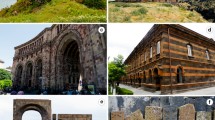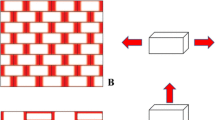Abstract
During the pre-colonial period all the architectural constructions of the Maya and the later Aztec culture were made from different types of rocks available in the nearby surroundings of the settlements. Later, the architecture characterizing the Spanish colonization utilized volcanic tuff rocks for ashlars and masonry facades. Volcanic tuffs were used in large quantities and are still the main natural building rock used in most of the country. Tuffs are mostly soft and porous rocks that can be easily cut and reworked. They are, however, very susceptible to the effects of weathering, especially the deterioration caused by salt crystallization. Seventeen volcanic tuff samples from Mexico used as natural building stones were studied. These tuffs show highly variable compositions and different porosities and textural properties as well as very different behaviors in regard to salt crystallization. The petrographic, petrophysical, mineralogical and geochemical properties of the 17 samples were analyzed before and after a large number of salt bursting tests in order to try and determine the main factors leading to the weathering caused by salt crystallization. Some factors appear to have a real importance in regard to the resistance against salt crystallization. Two of the most important are the water vapor diffusion (μ value) and the pore radii distribution; however, microporosity also becomes a relevant factor for rapid salt destruction if it reaches more than 50 % of the pore volume. All these effects related to the salt crystallization are dependent on the presence of water in any form, so the climatic conditions must also play a principal role.




















Similar content being viewed by others
References
Angeli M, Bigas JP, Benavente D, Menéndez B, Hébert R, David C (2007) Salt crystallization in pores: quantification and estimation of damage. Environ Geol 52:205–214
Angeli M, Benavente D, Bigas JP, Menéndez B, Hébert R, David CH (2008) Modification of the porous network by salt crystallization in experimentally weathered sedimentary stones. Mater Struct 41:1091–1108
Benavante D (2011) Why pore size is important in the deterioration of porous stones used in the build heritage. Macla, no. 15, Revista de la Sociedad Española de Mineralogia, Barcelona, p 41–42
Coussy O (2006) Deformation and stress from in-pore drying-induced crystallization of salt. J Mech Phys Solid 54(8):1517–1547
De Campos Bernardi AC, Peronti Anchão Oliviera P, De Melo Monte MB, Polidoro JC, Souza-Barros F (2010) Brazilian sedimentary zeolite use in agriculture. In: 19th world congress of soil science, soil solutions for a changing world 1–6 August 2010, Brisbane, Australia
Fitzner B, Snethlage R (1982) Einfluß der Porenradienverteilung auf das Verwitterungsverhalten asugewälter Sandsteine. Bautenschutz Bausanierung 5(3):97–103
Flatt RJ (2002) Salt damage in porous materials: how high supersaturations are generated. J Cryst Growth 242:435–454
Fookes PG, Dearman WR, Franklin JA (1971) Some engineering aspects of rock weathering with field examples from Dartmoor and elsewhere. Q J Eng GeolHydrogeol 4:139–185. doi:10.1144/GSL.QJEG.004.03.01
Grossi CM, Esbert RM (1994) Las sales solubles en el deterioro de rocas monumentales: revisión bibliográfica. Mater Construc 44(235):15–30
Lubelli B, van Hees RPJ, Nijland TG (2014) Salt crystallization damage: how realistic are existing ageing tests? In: De Clercq H (ed) SWBSS 2014 3th International Conference on Salt Weathering of Buildings and Stone Sculptures, Brussels, 14–16 October 2014, Royal Institute for Cultural Heritage (KIK/IRPA), pp 259–274
Peltier L (1950) The geographic cycle in periglacial regions as it is related to climatic geomorphology. Ann Assoc Am Geol 40:214–236
Rijniers LA, Huinink HP, Pel L, Kopinga K (2005) Experimental evidence of crystallization pressure inside porous media. Phys Rev Lett 94(7):075503-1–075503-4
Rodriguez-Navarro C, Doehne E (1999) Salt weathering: influence of evaporation rate, supersaturation and crystallization pattern. Earth Surf Proc Land 24:191–209
Ruedrich J, Siegesmund S (2006) Fabric dependence of length change behaviour induced by ice crystallisation in the pore space of natural building stones. In: Fort R, Alvarez de Buergo M, Gomez-Heras M (eds) Heritage, weathering and conservation. Taylor & Francis, London, pp 497–505
Ruedrich J, Siegesmund S (2007) Salt and ice crystallization in porous sandstones. Environ Geol 52:225–249
Scherer GW (1999) Crystallization in pores. Cem Concr Res 29:1347–1358
Siegesmund S, Duerrast H (2011) Physical and mechanical properties of rocks. In: Siegesmund S, Snethlage R (eds) Stone in architecture: properties, durability, 4th edn. Springer, Berlin, pp 97–225
Siegesmund S, Steiger M (2007) Special issue on salt decay. Environ Geol 52:185–420
Snethlage R (1984) Steinkonservierung. Arbeitsheft Bayer. Landesamt f. Denkmalpflege, 22, Munich
Steiger M (2005) Crystal growth in porous materials—I: the crystallization pressure of large crystals. J Cryst Growth 282:455–469
Steiger M, Carola AE, Sterflinger K (2011) (2013) Chapter 4—weathering and deterioration. In: Siegesmund S, Snethlage R (eds) Stone in architecture. Springer, Berlin/New York, pp 227–316
Torkashvand AM, Shadparvar V (2013) Effect of some organic waste and zeolite on water holding capacity and PWP delay of soil. Curr Biotica 6(4):459–465
Tsui N, Flatt RJ, Scherer GW (2003) Crystallization damage by sodium sulphate. J Cult Herit 4:109–115
Wedekind W, Ruedrich J, Siegesmund S (2011) Natural building stones of Mexico–Tenochtitlán: their use, weathering and rock properties at the Templo Mayor, Palace Heras Soto and the Metropolitan Cathedral. Environ Earth Sci 63(7/8):1787–1798
Wedekind W, López-Doncel R, Dohrmann R and Siegesmund S (2012) Hygric and hydric expansion of tuffs exclusively caused by clay minerals?—12th International Conference on the deterioriation and conservation of Stones, Extend abstracts book, New York (in press)
Wedekind W, López-Doncel R, Dohrmann R, Kocher M, Siegesmund S (2013) Weathering and deterioration of volcanic tuff rocks used as building stone causes by moisture expansion. Environ Earth Sci 69:1203–1224. doi:10.1007/s12665-012-2158-1
Winkler EM, Singer PC (1972) Crystallization pressure of salts in stone and concrete. Geol Soc Am Bull 83:3509–3514
Acknowledgments
Our work was supported by the Consejo Nacional de Ciencia y Tecnología, (CONACyT), Projects Ciencia Básica (CB-130282) and Cooperación Bilateral (191044), the German Science Foundation (DFG Si-438/44-1) and the Hans-Boeckler-Foundation. We are grateful to Erasmo Mata, Alejandro Rivera, Theresa Platz, Christopher Pötzl, Eneida Molina, Detlev Klosa, M. Sitnikova and Nohemi Cardona for their technical and laboratory support. Finally, the authors would also like to thank the two anonymous reviewers who with their thoughtful suggestions substantially improved this manuscript.
Author information
Authors and Affiliations
Corresponding author
Rights and permissions
About this article
Cite this article
López-Doncel, R., Wedekind, W., Leiser, T. et al. Salt bursting tests on volcanic tuff rocks from Mexico. Environ Earth Sci 75, 212 (2016). https://doi.org/10.1007/s12665-015-4770-3
Received:
Accepted:
Published:
DOI: https://doi.org/10.1007/s12665-015-4770-3




